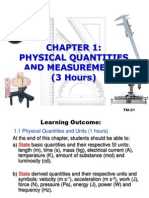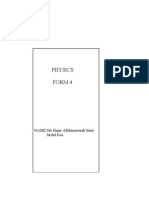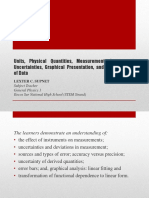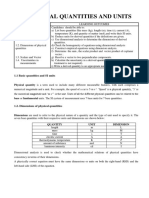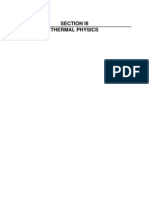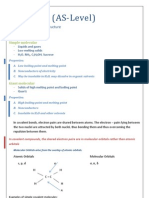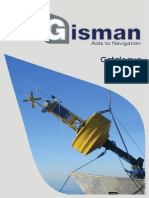Section I Measurement: - Page 3
Uploaded by
Tilak K CSection I Measurement: - Page 3
Uploaded by
Tilak K C- PAGE 3 -
SECTION I
MEASUREMENT
- PAGE 4 -
Chapter 1: Measurement
- SI Units
- Errors and Uncertainties
- Scalars and Vectors
a. Recall the following base quantities and their units; mass (kg), length (m), time (s), current (A),
temperature (K), amount of substance (mol).
Base Quantities
SI Units
Name Symbol
Length metre m
Mass kilogram kg
Time second s
Amount of substance mole mol
Temperature Kelvin K
Current ampere A
Luminous intensity candela cd
b. Express derived units as products or quotients of the base units and use the named units listed in
Summary of Key Quantities, Symbols and Units as appropriate.
A derived unit can be expressed in terms of products or quotients of base units.
Derived Quantities Equation Derived Units
Area (A) A = L
2
m
2
Volume (V) V = L
3
m
3
Density () =
m
V
kg
m
3 = kg m
-3
Velocity (v) v =
L
t
m
s
= m s
-1
Acceleration (a) a =
Av
t
m s
-1
s
= m s
-2
Momentum (p) p = m x v (kg)(m s
-1
) = kg m s
-1
Derived Quantities Equation
Derived Unit
Derived Units
Special Name Symbol
Force (F) F =
Ap
t
Newton N
kg m s
-1
s
= kg m s
-2
Pressure (p) p =
F
A
Pascal Pa
kg m s
-2
m
2 = kg m
-1
s
-2
Energy (E) E = F x d joule J (kg m s
-2
)(m) = kg m
2
s
-2
Power (P) P =
E
t
watt W
kg m
2
s
-2
s
= kg m
2
s
-3
Frequency (f) f =
1
t
hertz Hz
1
s
= s
-1
Charge (Q) Q = I x t coulomb C A s
Potential Difference
(V)
V =
E
Q
volt
V
kg m
2
s
-2
A s
= kg m
2
s
-3
A
-1
Resistance (R) R =
V
I
ohm O
kg m
2
s
-3
A
-1
A
= kg m
2
s
-3
A
-2
- PAGE 5 -
c. Show an understanding of and use the conventions for labelling graph axes and table columns as
set out in the ASE publication SI Units, Signs, Symbols and Systematics (The ASE Companion to 5-
16 Science, 1995).
Self-explanatory
d. Use the following prefixes and their symbols to indicate decimal sub-multiples or multiples of both
base and derived units: pico (p), nano (n), micro (), milIi (m), centi (c), deci (d), kilo (K), mega (M),
giga (G), tera (T).
Multiplying Factor Prefix Symbol
10
-12
pico p
10
-9
nano n
10
-6
micro
10
-3
milli m
10
-2
centi c
10
-1
deci d
10
3
kilo k
10
6
mega M
10
9
giga G
10
12
tera T
e. Make reasonable estimates of physical quantities included within the syllabus.
When making an estimate, it is only reasonable to give the figure to 1 or at most 2 significant figures since
an estimate is not very precise.
Physical Quantity Reasonable Estimate
Mass of 3 cans (330 ml) of Coke 1 kg
Mass of a medium-sized car 1000 kg
Length of a football field 100 m
Reaction time of a young man 0.2 s
- Occasionally, students are asked to estimate the area under a graph. The usual method of
counting squares within the enclosed area is used. (eg. Topic 3 (Dynamics), N94P2Q1c)
- Often, when making an estimate, a formula and a simple calculation may be involved.
EXAMPLE 1E1
Estimate the average running speed of a typical 17-year-olds 2.4-km run.
velocity =
distance
time
=
2400
12.5 x 60
= 3.2
~ 3 m s
-1
EXAMPLE 1E2 (N08/ I/ 2)
Which estimate is realistic?
Option Explanation
A The kinetic energy of a
bus travelling on an
expressway is 30 000 J
A bus of mass m travelling on an expressway will travel between 50 to
80 km h
-1
, which is 13.8 to 22.2 m s
-1
. Thus, its KE will be approximately
m(18
2
) = 162m. Thus, for its KE to be 30 000J: 162m = 30 000. Thus,
m = 185kg, which is an absurd weight for a bus; ie. This is not a realistic
estimate.
B The power of a domestic
light is 300 W.
A single light bulb in the house usually runs at about 20 W to 60 W.
Thus, a domestic light is unlikely to run at more than 200W; this estimate
is rather high.
C The temperature of a hot
oven is 300 K.
300K = 27
0
C. Not very hot.
- PAGE 6 -
D The volume of air in a
car tyre is 0.03 m
3
.
Estimating the width of a tyre, t, is
15 cm or 0.15 m, and estimating R
to be 40 cm and r to be 30 cm,
volume of air in a car tyre is
= (R
2
r
2
)t
= (0.4
2
0.3
2
)(0.15)
= 0.033 m
3
0.03 m
3
(to one sig. fig.)
f.
g.
Show an understanding of the distinction between systematic errors (including zero errors) and
random errors.
Show an understanding of the distinction between precision and accuracy.
Random error is the type of error which causes readings to scatter about the true value.
Systematic error is the type of error which causes readings to deviate in one direction from the true value.
Precision: refers to the degree of agreement (scatter, spread) of repeated measurements of the same
quantity. {NB: regardless of whether or not they are correct.}
Accuracy refers to the degree of agreement between the result of a measurement and the true value of the
quantity.
R Error Higher
Less Precise
S
E
r
r
o
r
H
i
g
h
e
r
L
e
s
s
A
c
c
u
r
a
t
e
h. Assess the uncertainty in a derived quantity by simple addition of actual, fractional or percentage
uncertainties (a rigorous statistical treatment is not required).
For a quantity x = (2.0 0.1) mm,
Actual/ Absolute uncertainty, A x = 0.1 mm
Fractional uncertainty,
x
x
= 0.05
Percentage uncertainty,
x
x
100% = 5 %
If p =
2x + y
3
or p =
2x - y
3
, p =
2x + y
3
If r = 2xy
3
or r =
2x
y
3 ,
r
r
=
x
x
+
3y
y
Actual error must be recorded to only 1 significant figure, &
The number of decimal places a calculated quantity should have is determined by its actual error.
true value true value
true value true value
R
r
- PAGE 7 -
For eg, suppose g has been initially calculated to be 9.80645 m s
-2
& Ag has been initially calculated to be
0.04848 m s
-2
. The final value of Ag must be recorded as 0.05 m s
-2
{1 sf }, and the appropriate recording of
g is (9.81 0.05) m s
-2
.
i. Distinguish between scalar and vector quantities, and give examples of each.
Type Scalar Vector
Definition A scalar quantity has a magnitude only. It
is completely described by a certain
number and a unit.
A vector quantity has both magnitude and
direction. It can be described by an arrow
whose length represents the magnitude of
the vector and the arrow-head represents
the direction of the vector.
Examples Distance, speed, mass, time, temperature,
work done, kinetic energy, pressure,
power, electric charge etc.
Common Error:
Students tend to associate kinetic energy
and pressure with vectors because of the
vector components involved. However,
such considerations have no bearings on
whether the quantity is a vector or scalar.
Displacement, velocity, moments (or
torque), momentum, force, electric field etc.
j.
k.
Add and subtract coplanar vectors.
Represent a vector as two perpendicular components.
In the diagram below, XY represents a flat kite of weight 4.0 N. At a certain instant, XY is inclined at 30
o
to
the horizontal and the wind exerts a steady force of 6.0 N at right angles to XY so that the kite flies freely.
By accurate scale drawing By calculations using sine and cosine rules, or Pythagoras
theorem
Draw a scale diagram to find the
magnitude and direction of the
resultant force acting on the
kite.
Scale: 1 cm 1.0 N
Using cosine rule, a
2
= b
2
+ c
2
2bc cos A
R
2
= 4
2
+ 6
2
-2(4)(6)(cos 30)
R = 3.23 N
30
o
4.0 N
6.0 N
resultant, R
o
30
o
4.0 N
6.0 N
resultant, R
u
30
o
4.0 N
6.0 N
X
Y
- PAGE 8 -
R = 3.2 N ( 3.2 cm)
at u = 112
0
to the 4 N vector.
Using sine rule,
a
sin A
=
b
sin B
6
sin o
=
3.23
sin 30
o = 68or 112
= 112to the 4 N vector
Summing Vector Components
Fx = - 6 sin 30
0
= - 3 N
Fy = 6 cos 30
0
- 4
= 1.2 N
R = (-3)
2
+ (1.2)
2
= 3.23 N
tan u =
1.2
3
u = 22
0
R is at an angle 112
0
to the 4 N vector. (90
0
+ 22
0
)
u
30
o
4.0 N
6.0 N
X
Y
You might also like
- Conveyor Belt Design Manual Contitech - Eng100% (12)Conveyor Belt Design Manual Contitech - Eng140 pages
- Practical Guide of Physical Education (1912 Edition)100% (2)Practical Guide of Physical Education (1912 Edition)92 pages
- Innova Junior College Physics AssignmentsNo ratings yetInnova Junior College Physics Assignments295 pages
- Topic 1 Measurements: Lecture Assignment 1ANo ratings yetTopic 1 Measurements: Lecture Assignment 1A11 pages
- Topic 1 Physical Quantities and Units PPT Student 2022No ratings yetTopic 1 Physical Quantities and Units PPT Student 202230 pages
- Notes - Topic 1 Physical Quantities and Units - CAIE Physics A-LevelNo ratings yetNotes - Topic 1 Physical Quantities and Units - CAIE Physics A-Level6 pages
- Senior General Physics 1 Module 1 For PrintingNo ratings yetSenior General Physics 1 Module 1 For Printing26 pages
- Prepared by Engr. Larissa G. Saculles: 08 Jan 2024 - EngrlgsNo ratings yetPrepared by Engr. Larissa G. Saculles: 08 Jan 2024 - Engrlgs13 pages
- Definitions & Notes - Topic 1 Physical Quantities and Units - CAIE Physics A-levelNo ratings yetDefinitions & Notes - Topic 1 Physical Quantities and Units - CAIE Physics A-level7 pages
- Physics Form 4: Name:Siti Hajar Almunawarah Binti Mohd EsaNo ratings yetPhysics Form 4: Name:Siti Hajar Almunawarah Binti Mohd Esa13 pages
- Reka Bentuk, Pembinaan Dan Pentadbiran UjianNo ratings yetReka Bentuk, Pembinaan Dan Pentadbiran Ujian9 pages
- Topik 1 DBS10012 Physical Quantities MeasurementNo ratings yetTopik 1 DBS10012 Physical Quantities Measurement60 pages
- 1.0 Measurements and Physical QuantitiesNo ratings yet1.0 Measurements and Physical Quantities29 pages
- Chapter 1 Physical Quantities and Units Checked PDFNo ratings yetChapter 1 Physical Quantities and Units Checked PDF6 pages
- Generalphysics1 q1 Mod1 Measurement-Properties-And-Physical-Quantities v1No ratings yetGeneralphysics1 q1 Mod1 Measurement-Properties-And-Physical-Quantities v132 pages
- Topic 1 AS Physical Quantities and Units NotesNo ratings yetTopic 1 AS Physical Quantities and Units Notes9 pages
- Student Solutions Manual to Accompany Economic Dynamics in Discrete Time, secondeditionFrom EverandStudent Solutions Manual to Accompany Economic Dynamics in Discrete Time, secondedition4.5/5 (2)
- Chapter 14 Nitrogen and Sulphur (Chemistry AS - Level)No ratings yetChapter 14 Nitrogen and Sulphur (Chemistry AS - Level)3 pages
- Chapter 2 Atoms, Molecules and Stoichiometry100% (1)Chapter 2 Atoms, Molecules and Stoichiometry8 pages
- Chapter 16b (AS-Level) : Physical Properties of AlkenesNo ratings yetChapter 16b (AS-Level) : Physical Properties of Alkenes7 pages
- Chapter 4 - States of Matter (Chemistry AS - Level)No ratings yetChapter 4 - States of Matter (Chemistry AS - Level)6 pages
- Chapter 7a - Equilibria (Chemistry AS - Level)No ratings yetChapter 7a - Equilibria (Chemistry AS - Level)10 pages
- Chapter 8a - Reaction Kinetics (Chemistry AS - Level)No ratings yetChapter 8a - Reaction Kinetics (Chemistry AS - Level)8 pages
- Chapter 10a Group II (Chemistry AS - Level)No ratings yetChapter 10a Group II (Chemistry AS - Level)3 pages
- Chapter 6 - Electrochemistry (Chemistry AS - Level)No ratings yetChapter 6 - Electrochemistry (Chemistry AS - Level)6 pages
- Chapter 3 Chemical Bonding and StructureNo ratings yetChapter 3 Chemical Bonding and Structure11 pages
- Chapter 1 - Atomic Structure Discovering The Electron (Chemistry AS - Level)No ratings yetChapter 1 - Atomic Structure Discovering The Electron (Chemistry AS - Level)11 pages
- Units: 3. U.S. Units of Measurement 4. Tables of EquivalentsNo ratings yetUnits: 3. U.S. Units of Measurement 4. Tables of Equivalents8 pages
- Download ebooks file (Ebook) Essential Algebra for Chemistry Students, 2nd Edition by Ball, David W. ISBN 9780495013273, 0495013277 all chapters100% (2)Download ebooks file (Ebook) Essential Algebra for Chemistry Students, 2nd Edition by Ball, David W. ISBN 9780495013273, 0495013277 all chapters81 pages
- Looking Forward: Weights and Measurements in BakingNo ratings yetLooking Forward: Weights and Measurements in Baking12 pages
- (SV) Topic 1 Introduction To MeasurementNo ratings yet(SV) Topic 1 Introduction To Measurement18 pages
- PHYS 1220 Coulomb's Law and Electric Fields SolutionsNo ratings yetPHYS 1220 Coulomb's Law and Electric Fields Solutions20 pages
- General Instructions:: CBSE Class 9 - Science Sample Paper-11 (2017-18)No ratings yetGeneral Instructions:: CBSE Class 9 - Science Sample Paper-11 (2017-18)3 pages
- 6129-202 Key Plumbing Principles Version A FinalNo ratings yet6129-202 Key Plumbing Principles Version A Final5 pages
- Chapter 1 Physical Quantities and Units F6No ratings yetChapter 1 Physical Quantities and Units F637 pages
- Practical Guide of Physical Education (1912 Edition)Practical Guide of Physical Education (1912 Edition)
- Topic 1 Physical Quantities and Units PPT Student 2022Topic 1 Physical Quantities and Units PPT Student 2022
- Notes - Topic 1 Physical Quantities and Units - CAIE Physics A-LevelNotes - Topic 1 Physical Quantities and Units - CAIE Physics A-Level
- Prepared by Engr. Larissa G. Saculles: 08 Jan 2024 - EngrlgsPrepared by Engr. Larissa G. Saculles: 08 Jan 2024 - Engrlgs
- Definitions & Notes - Topic 1 Physical Quantities and Units - CAIE Physics A-levelDefinitions & Notes - Topic 1 Physical Quantities and Units - CAIE Physics A-level
- Physics Form 4: Name:Siti Hajar Almunawarah Binti Mohd EsaPhysics Form 4: Name:Siti Hajar Almunawarah Binti Mohd Esa
- Chapter 1 Physical Quantities and Units Checked PDFChapter 1 Physical Quantities and Units Checked PDF
- Generalphysics1 q1 Mod1 Measurement-Properties-And-Physical-Quantities v1Generalphysics1 q1 Mod1 Measurement-Properties-And-Physical-Quantities v1
- Student Solutions Manual to Accompany Economic Dynamics in Discrete Time, secondeditionFrom EverandStudent Solutions Manual to Accompany Economic Dynamics in Discrete Time, secondedition
- Chapter 14 Nitrogen and Sulphur (Chemistry AS - Level)Chapter 14 Nitrogen and Sulphur (Chemistry AS - Level)
- Chapter 16b (AS-Level) : Physical Properties of AlkenesChapter 16b (AS-Level) : Physical Properties of Alkenes
- Chapter 4 - States of Matter (Chemistry AS - Level)Chapter 4 - States of Matter (Chemistry AS - Level)
- Chapter 8a - Reaction Kinetics (Chemistry AS - Level)Chapter 8a - Reaction Kinetics (Chemistry AS - Level)
- Chapter 6 - Electrochemistry (Chemistry AS - Level)Chapter 6 - Electrochemistry (Chemistry AS - Level)
- Chapter 1 - Atomic Structure Discovering The Electron (Chemistry AS - Level)Chapter 1 - Atomic Structure Discovering The Electron (Chemistry AS - Level)
- Units: 3. U.S. Units of Measurement 4. Tables of EquivalentsUnits: 3. U.S. Units of Measurement 4. Tables of Equivalents
- Download ebooks file (Ebook) Essential Algebra for Chemistry Students, 2nd Edition by Ball, David W. ISBN 9780495013273, 0495013277 all chaptersDownload ebooks file (Ebook) Essential Algebra for Chemistry Students, 2nd Edition by Ball, David W. ISBN 9780495013273, 0495013277 all chapters
- Looking Forward: Weights and Measurements in BakingLooking Forward: Weights and Measurements in Baking
- PHYS 1220 Coulomb's Law and Electric Fields SolutionsPHYS 1220 Coulomb's Law and Electric Fields Solutions
- General Instructions:: CBSE Class 9 - Science Sample Paper-11 (2017-18)General Instructions:: CBSE Class 9 - Science Sample Paper-11 (2017-18)
































